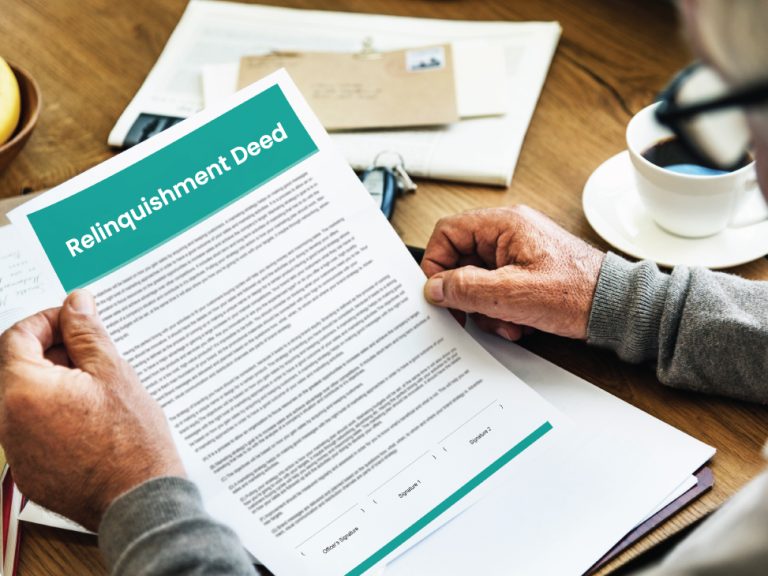Getting home loan is very BASIC now
Get a loan in under 5 mins

When dealing with property ownership, the term “relinquishment deed” often comes up, especially in cases involving family property. Understanding what a relinquishment deed is, its format, and the registration process is crucial for anyone navigating property transfers. This comprehensive guide will delve into every aspect of a relinquishment deed, providing clarity on its meaning, format, registration process, and other important considerations.
Table of Contents
A relinquishment deed is a legal document used to transfer ownership of property from one co-owner to another. It is often used among family members to transfer property rights without any monetary transaction. The primary focus is to relinquish or give up one’s share in the property, allowing the other co-owners to gain full ownership.
Several situations may necessitate the creation of a relinquishment deed:
Suggested read: Partition Deed
Any co-owner of a property can execute a relinquishment deed, provided it is done voluntarily and without coercion. All parties must be of legal age and sound mind.
The registration charges for a relinquishment deed can vary from city to city. For Delhi, the registration fee for a relinquishment deed is Rs 1,000 per instrument plus a Rs 100 pasting fee. Further, the fees charged by professional property lawyers and advocates may vary depending on their service charges.
Suggested read: Lost Your Property Documents
According to a Bombay High Court ruling, an unregistered relinquishment deed cannot be used as evidence in court, highlighting the necessity of proper registration. It is compulsory to register a relinquishment deed to make the transfer of property rights legally valid. This requirement is governed by Section 17 (1) b of the Registration Act, 1908. This act serves as a tool to validate the transfer of the right of immovable property to another co-owner, thereby legalizing the process of property transfer under the Transfer of Property Act.
Executing a relinquishment deed involves several key steps with specific timelines to ensure legal validity. After drafting the deed, the first step is to pay the applicable stamp duty based on state-specific laws, a crucial step for legal validation.
Once the stamp duty is paid, the deed must be executed, which involves signing by all parties in the presence of witnesses, typically completed within 5-7 business days.
Following the execution, the deed must be submitted for registration within four months of the execution date. If this timeline is not met, an additional four-month grace period is available, subject to a penalty that can be up to ten times the registration fee. The sub-registrar’s office will then take approximately 15 days to verify and process the registration.
Once the registration is complete, the registered deed can be collected from the sub-registrar’s office within 15 days. Overall, the entire process, from drafting to collecting the registered deed, takes about 1-2 months. Adhering to these timelines ensures the deed is legally valid and enforceable.
To execute a relinquishment deed, you generally need:
Revocation of a relinquishment deed is possible but requires mutual consent from all parties involved. Understanding the legal implications and procedures is crucial. Further, the relinquishment deed can typically be revoked within three years from the date the rights were transferred. After this period, revocation becomes more challenging and may require legal intervention.
Registration of a relinquishment deed is mandatory. As per the Transfer of Property Act, unregistered deeds are invalid and cannot be used as legal evidence.
A standard relinquishment deed includes:
If any party involved in the relinquishment deed is unable to visit the sub-registrar’s office, they can provide a letter of relinquishment or Power of Attorney (PoA) to a trusted individual to act on their behalf. This PoA must be registered and authorized by the appropriate authorities to ensure its validity.
While both relinquishment and gift deeds involve the transfer of property without monetary consideration, they differ significantly:
| Relinquishment Deed | Gift Deed |
| Transfer property rights among co-owners, usually within a family | Transfer property to any individual |
| No monetary consideration | No monetary consideration |
| Does not require acceptance by the recipient | Requires acceptance by the recipient to be legally valid |
| Often used in cases of inheritance or family settlements | Can be used for transferring property to friends, relatives, or anyone |
| Can be revoked within a specific time frame, often with consent | Generally irrevocable once accepted by the recipient |
| Mandatory to register to be legally valid | Mandatory to register to be legally valid |
There is no specific time limit for executing a relinquishment deed, but it should be registered promptly to ensure legality and avoid disputes. After drafting the deed and paying the applicable stamp duty, all parties must sign it in the presence of witnesses, typically within 5-7 business days. The deed must then be submitted for registration within four months of execution. If this timeline is missed, an additional four-month grace period is available, subject to a penalty of up to ten times the registration fee. The sub-registrar’s office typically takes about 15 days to verify and process the registration.
Yes, a relinquishment deed can be canceled, but it usually requires the mutual consent of all parties involved. Legal recourse may be necessary if there are disputes.
Yes, it is necessary to register a relinquishment deed to make it legally binding. Unregistered deeds are not enforceable in a court of law and may lead to disputes.
No, a relinquishment deed is used to transfer property rights among co-owners without consideration, usually among family members. To sell property, a sale deed is required.
A registered relinquishment deed is valid indefinitely, provided it is executed voluntarily, without coercion, and complies with all legal requirements.
A relinquishment deed can only be used among co-owners of a property, usually within a family, and cannot be used to transfer property to a third party.
Published on 22nd July 2024